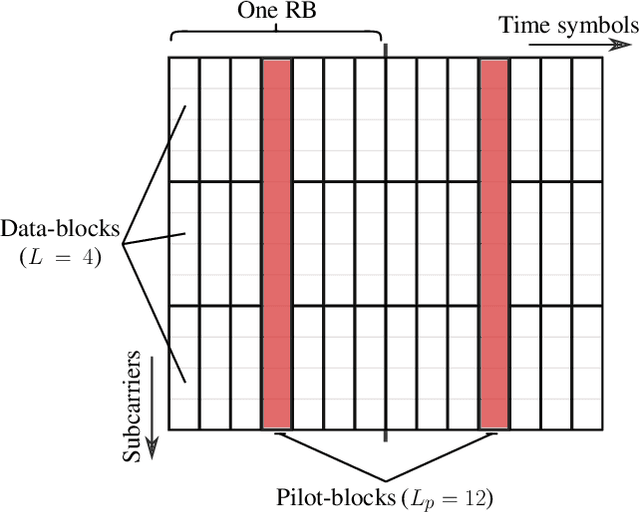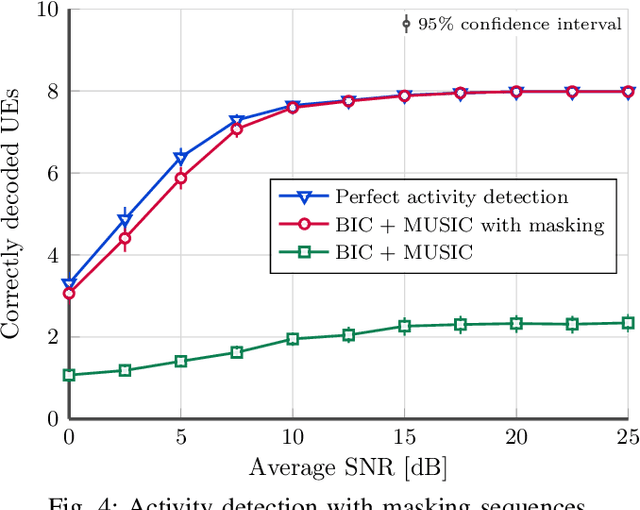Bashar Tahir
Identification of RIS-Assisted Paths for Wireless Integrated Sensing and Communication
Jun 04, 2025Abstract:Distinguishing between reconfigurable intelligent surface (RIS) assisted paths and non-line-of-sight (NLOS) paths is a fundamental problem for RIS-assisted integrated sensing and communication. In this work, we propose a pattern alternation scheme for the RIS response that uses part of the RIS as a dynamic part to modulate the estimated channel power, which can considerably help the user equipments (UEs) to identify the RIS-assisted paths. Under such a dynamic setup, we formulate the detection framework for a single UE, where we develop a statistical model of the estimated channel power, allowing us to analytically evaluate the performance of the system. We investigate our method under two critical factors: the number of RIS elements allocated for the dynamic part and the allocation of RIS elements among different users. Simulation results verify the accuracy of our analysis.
PLAIN: Scalable Estimation Architecture for Integrated Sensing and Communication
Mar 27, 2025Abstract:Integrated sensing and communication (ISAC) is envisioned be to one of the paradigms upon which next-generation mobile networks will be built, extending localization and tracking capabilities, as well as giving birth to environment-aware wireless access. A key aspect of sensing integration is parameter estimation, which involves extracting information about the surrounding environment, such as the direction, distance, and velocity of various objects within. This is typically of a high-dimensional nature, which leads to significant computational complexity, if performed jointly across multiple sensing dimensions, such as space, frequency, and time. Additionally, due to the incorporation of sensing on top of the data transmission, the time window available for sensing is likely to be short, resulting in an estimation problem where only a single snapshot is accessible. In this work, we propose PLAIN, a tensor-based estimation architecture that flexibly scales with multiple sensing dimensions and can handle high dimensionality, limited measurement time, and super-resolution requirements. It consists of three stages: a compression stage, where the high dimensional input is converted into lower dimensionality, without sacrificing resolution; a decoupled estimation stage, where the parameters across the different dimensions are estimated in parallel with low complexity; an input-based fusion stage, where the decoupled parameters are fused together to form a paired multidimensional estimate. We investigate the performance of the architecture for different configurations and compare it against practical sequential and joint estimation baselines, as well as theoretical bounds. Our results show that PLAIN, using tools from tensor algebra, subspace-based processing, and compressed sensing, can scale flexibly with dimensionality, while operating with low complexity and maintaining super-resolution.
Impact of Channel Correlation on Subspace-Based Activity Detection in Grant-Free NOMA
Feb 22, 2022



Abstract:In this paper, we consider the problem of activity detection in grant-free code-domain non-orthogonal multiple access (NOMA). We focus on performing activity detection via subspace methods under a setup where the data and pilot spreading signatures are of different lengths, and consider a realistic frame-structure similar to existing mobile networks. We investigate the impact of channel correlation on the activity detection performance; first, we consider the case where the channel exhibits high correlation in time and frequency and show how it can heavily deteriorate the performance. To tackle that, we propose to apply user-specific masking sequences overlaid on top of the pilot signatures. Second, we consider the other extreme with the channel being highly selective, and show that it can also negatively impact the performance. We investigate possible pilots' reallocation strategies that can help reduce its impact.
RIS-Assisted Code-Domain MIMO-NOMA
Mar 11, 2021



Abstract:We consider the combination of uplink code-domain non-orthogonal multiple access (NOMA) with massive multiple-input multiple-output (MIMO) and reconfigurable intelligent surfaces (RISs). We assume a setup in which the base station (BS) is capable of forming beams towards the RISs under line-of-sight conditions, and where each RIS is covering a cluster of users. In order to support multi-user transmissions within a cluster, code-domain NOMA via spreading is utilized. We investigate the optimization of the RIS weights such that a large number of users is supported. As it turns out, it is a coupled optimization problem that depends on the detection order under interference cancellation and the applied filtering at the BS. We propose to decouple those variables by using sum-rate optimized weights as the initial solution, allowing us to obtain a decoupled estimate of those variables. Then, in order to determine the final weights, the problem is relaxed into a semidefinite program that can be solved efficiently via convex optimization algorithms. Simulation results show the effectiveness of our approach in improving the detectability of the users.
Outage Analysis of Uplink IRS-Assisted NOMA under Elements Splitting
Mar 02, 2021



Abstract:In this paper, we investigate the outage performance of an intelligent reflecting surface (IRS)-assisted non-orthogonal multiple access (NOMA) uplink, in which a group of the surface reflecting elements are configured to boost the signal of one of the user equipments (UEs), while the remaining elements are used to boost the other UE. By approximating the received powers as Gamma random variables, tractable expressions for the outage probability under NOMA interference cancellation are obtained. We evaluate the outage over different splits of the elements and varying pathloss differences between the two UEs. The analysis shows that for small pathloss differences, the split should be chosen such that most of the IRS elements are configured to boost the stronger UE, while for large pathloss differences, it is more beneficial to boost the weaker UE. Finally, we investigate a robust selection of the elements' split under the criterion of minimizing the maximum outage between the two UEs.
 Add to Chrome
Add to Chrome Add to Firefox
Add to Firefox Add to Edge
Add to Edge